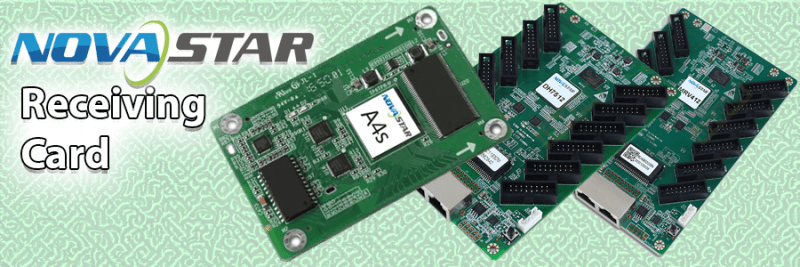NovaStar Receiving Card: Which One to Use?
Hampus Niskala |23/04, 2024

Selecting the appropriate receiving card is crucial for the success of your LED display project. The receiving card plays a vital role in ensuring that your display delivers high-quality visuals and operates efficiently. At NovaStar Shop, we offer a range of receiving cards tailored to meet various project requirements. Here’s a guide to help you choose the right receiving card for your LED display project.
A5s Receiving Card: The Reliable Choice for Basic Needs
A5s is an excellent choice for small to medium-sized LED displays that require reliable performance and basic functionality. Here are some of its key features:
- Resolution Support: Up to 320×256@60Hz.
- Calibration: Pixel-level brightness and chroma calibration.
- Gamma Adjustment: Individual gamma adjustment for red, green, and blue.
- Rotation: Supports 90° image rotation and free image rotation.
- EMC Class B Compliance: Ensures improved electromagnetic compatibility.
Ideal For: Small to medium-sized displays in retail, corporate, and educational settings where basic calibration and reliable performance are essential.
A8s Receiving Card: Enhanced Performance for Larger Displays
A8s is designed for medium to large-sized LED displays that demand higher performance and advanced features. Here’s what it offers:
- Resolution Support: Up to 512×384@60Hz.
- Data Output: Supports up to 40 groups of parallel RGB data or 64 groups of serial data (expandable to 128 groups).
- HDR Support: High Dynamic Range for better color and contrast.
- Stability: High-density connectors for improved stability.
- Low Latency: Ensures smooth and responsive display performance.
A10s Pro Receiving Card: The Ultimate Choice for High-End Projects
A10s Pro is the top-tier receiving card for large and complex LED display installations that require the highest level of performance and advanced capabilities. Key features include:
- Resolution Support: Up to 512×512@60Hz.
- Dynamic Booster: Enhances contrast and image details.
- Full-Grayscale Calibration: Ensures uniform brightness and color across the display.
- Adaptive Frame Rate: Supports up to 240Hz for smooth motion.
- Thermal Compensation: Maintains optimal performance in varying temperatures.
- Multi-Mode Support: Versatile for different display configurations.
Making the Right Choice
When choosing a receiving card for your LED display project, consider the following factors:
- Performance Requirements: Determine the level of performance and features needed for your specific application.
- Environment: Consider the operating environment and any special requirements such as HDR support or thermal compensation.
By carefully evaluating these factors, you can select the receiving card that best meets your project’s needs and ensures optimal performance and visual quality.
For more information or to purchase the right receiving card for your project, contact our support team at [email protected]. Our experts are here to help you make the best choice for your LED display project.

 Svenska
Svenska
 Polskie
Polskie
 Español
Español
 Italiano
Italiano
 Deutsch
Deutsch
 Français
Français
 Nederlands
Nederlands